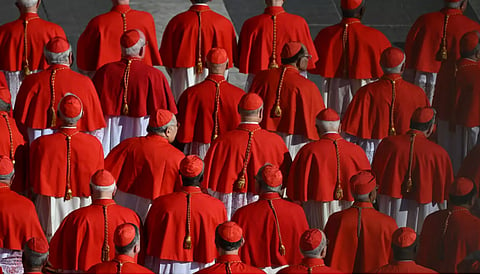11 steps: How a new Pope is elected
Apostolic Constitution 'Universi Dominici Gregis' outlines procedures for electing pontiff

Here's a step-by-step guide to how a new Pope is elected, based on current Roman Catholic Church procedures, especially as outlined by the Apostolic Constitution Universi Dominici Gregis and updated rules by Pope Benedict XVI and Pope Francis:
1. Death or Resignation of the Pope
The papacy becomes vacant when the pope dies or resigns (as Benedict XVI did in 2013).
The Camerlengo (Chamberlain of the Holy Roman Church) confirms the death and seals the papal apartments.
2. Nine Days of Mourning – “Novemdiales”
Nine days of official mourning follow the Pope’s death.
During this time, daily Requiem Masses are held.
3. Sede Vacante Begins
"Sede Vacante" means "the seat is vacant."
During this time, no major decisions about Church doctrine or direction can be made.
The College of Cardinals takes temporary charge of Church administration.
4. Conclave Preparation
Held in the Sistine Chapel in Vatican City.
Only cardinal electors under age 80 (maximum 120 in number) are eligible to vote.
The cardinals are sworn to secrecy and are sequestered—cut off from the outside world.
5. Oath of Secrecy
Each cardinal elector takes an oath before voting begins:
“I promise, pledge and swear to observe absolute and perpetual secrecy...”
6. Voting Begins: 2/3 needed
Ballots are cast twice in the morning and twice in the afternoon (four times per day).
A candidate must receive a two-thirds majority to be elected.
7. Voting Procedure
Each vote follows this pattern:
Each cardinal writes a name on a secret ballot.
The ballots are collected and counted.
The votes are read aloud and tallied by scrutineers.
The ballots are burned in a special stove.
8. Smoke Signals
After each voting round, the ballots are burned:
Black smoke (fumata nera) = no Pope elected.
White smoke (fumata bianca) = new Pope elected!
Also Read: Video: Pope Francis's historic UAE visit
9. Acceptance
Once someone gets a 2/3 majority, the Dean of the College of Cardinals asks:
“Do you accept your canonical election as Supreme Pontiff?”
If accepted, the new pope chooses a papal name.
10. Dressing the New Pope
The new Pope is led to the Room of Tears, where he changes into the white papal garments prepared in several sizes.
11. Public Announcement – “Habemus Papam”
The Cardinal Protodeacon (currently Cardinal Jean-Louis Tauran during Francis’s election) steps out onto the balcony of St. Peter’s Basilica and announces:
"Habemus Papam!" ("We have a Pope!")
The new Pope appears and gives his first Urbi et Orbi (to the City, and to the World) blessing.
Sign up for the Daily Briefing
Get the latest news and updates straight to your inbox



